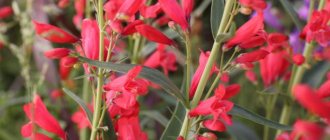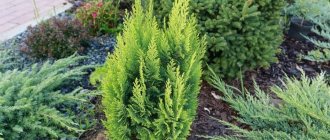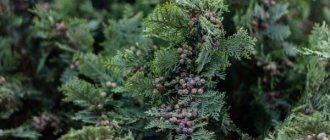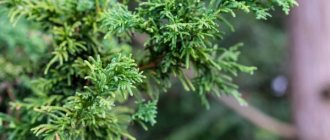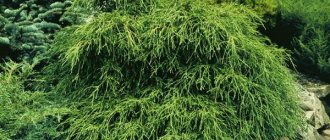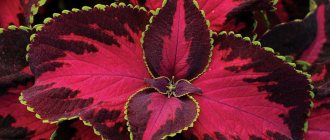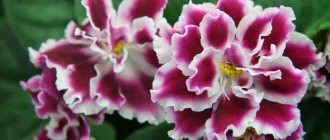Description of the genus
Cypress is a woody coniferous crop, more common in southern regions with mild winters, although some of its species are winter-hardy. In Siberia and the Far East, tub maintenance is used, when the plant is taken outside only in the warm season.
Cypress is native to the forests and plains of Japan, Taiwan, and North America. There, individual specimens can reach 70-100 m. The wide growing area causes a wide variety of species. In the 18th century, the plant with its openwork crown and bright needles interested breeders, and from that time its active cultivation began.
Today, the decorative cypress is a slender tree or shrub with a columnar, pyramidal or cone-shaped crown. Depending on the type, its branches are spread horizontally or droop along the trunk. The modified foliage looks like soft pine needles. Its color, depending on the variety and age of the plant, can vary from golden, yellow-green, light green to blue and dark green.
During the growing season, the ends of the shoots are covered with male and female flowers. Small cones, after ripening, open. Each scale produces 2 winged seeds, which can produce viable sprouts already in the first year of the plant’s life.
The plant has a branched root system that develops well in soil with a neutral or slightly acidic pH.
Cypress in landscape design
Cypress tolerates urban conditions and grows in shade and partial shade. In hot weather, its growth slows down. The tree is sensitive to moisture deficiency in the soil and air, so before planting, consider an irrigation system. Cypress is suitable for decorating recreation areas of country houses, sanatoriums, recreation centers, and parks.
Cypress needles are highly decorative. The color depends on the variety; it ranges from light green to deep dark. Plants with golden and bluish-smoky needles are especially valued.
Due to its high winter hardiness and unpretentiousness, cypress is successfully grown in the middle zone. Depending on the variety, trees have different sizes. Tall hybrids are more often used in single plantings. Primroses and perennial herbs grow well under them.
Cypress is used for single and group plantings. A gap of 1 to 2.5 m is maintained between plants. Trees are suitable for creating a hedge, then a gap of 0.5–1 m is maintained between them.
Advice! Low-growing varieties of cypress are used in flower beds, rocky gardens, alpine hills and terraces.
Lawson cypress and pea fruit are grown indoors. Plants are planted in small containers and pots. They are placed on windows or verandas on the north side. To prevent the tree from growing, it is grown using the bonsai technique.
Types and varieties
Today, there are 7 main varieties of coniferous crops, on the basis of which breeders have developed many varieties that differ in size, crown shape, and needle color. In Russia, the most resistant to harsh climatic conditions are cultivated cypress species.
Cypress pea
Pea cypress is an unpretentious tree plant native to the Japanese Islands. It is resistant to frost and thrives in damp soils. It grows very slowly, in 10 years it stretches only 40 cm. The tree has a branched crown in the shape of a wide cone, formed by horizontally growing branches. It has beautiful gray-blue needles.
The most popular varieties of the cypress genus are:
- Boulevard - blue cypress. This is a low tree, up to 5 meters high. The crown has a shape reminiscent of a pin. It is distinguished by silver-blue needles with awl-shaped, curved needles. Loves good lighting and moist soil. It grows better in the southern regions, where there are no severe frosts, and is not frost-resistant.
- Filifera nana (Filifera nana) cypress is a fluffy shrub with a spherical crown that does not require shaping. Grows well both indoors and outdoors under mild climate conditions. It has a long lifespan - up to 300 years. Belongs to dwarf varieties - an adult plant does not exceed 50 cm.
- Filifera Gracil or filamentous is a tall shrub reaching 5 meters. It has a weeping crown of a conical shape - its thin, drooping branches look like long threads. The needles are dark green, scaly. Very frost-resistant.
Nutkan cypress
Young Nootkan cypress has a narrow or pyramid-shaped crown formed by ascending shoots with hanging ends. The dense brown bark becomes cracked over time and moves away from the trunk. The needles are dark green, scaly, with needles pointed towards the top. The flowering period begins in April.
- Pendula (Weeping) is a drought-resistant tree reaching a height of 15 meters. Hanging branches form a weeping crown with dark blue needles. It is characterized by slow growth, rising 20 cm per year. Unpretentious, tolerates shade well, although it feels better in places exposed to the sun. Does not require frequent feeding, but abundant watering is necessary.
- Glauka is a tree-type cypress up to 20 m high. The crown has the shape of a cone. In the lower wide part it can reach 7 m in diameter. The needles are blue, scaly. The plant is not frost-resistant.
Lawson's cypress
Lawson's cypress is a tall shrub with the shape of its branches and the color of its needles, reminiscent of thuja. Horizontal or hanging branches form a conical crown. The needles are soft, sharp, and consist of small scales. During the flowering period, bright red male flowers appear at the ends of the shoots and small, green female flowers appear. The cones are round and resinous. The most popular varieties of this species:
- Blue surprise - the name corresponds to the deep blue color of the needles. The narrow columnar crown consists of vertical branches. It grows 10-20 cm per year. The bark of the trunk is a rich, reddish-brown color.
- Columnaris is a coniferous tree with a narrow columnar crown, reaching a height of 4 m. It is formed by vertical branches pressed to the trunk with flat bluish needles. The plant is used to create a hedge.
- Elwoodi is a low cypress tree that grows to 1.5 meters in 10 years. The crown is cone-shaped, pointed towards the apex. Very beautiful in home compositions. It has moderate frost resistance.
Cypress Dull
The blunt-leaved cypress is a tree-like form, reaching 25 m in height. When bred at home, its height is no more than 5 meters. In accordance with its name, it has bright green needles rounded at the ends. Round small cones contain from 8 to 12 scales. Main varieties:
- Pygmy is a Japanese variety characterized by very slow growth. In 10 years, its representatives grow to only 75 cm. They love the sun, and in the shade they drop branches, breaking the shape of the crown. The shrub is hardy, with proper care and proper protection of the roots it can withstand frost down to minus 30 ° C
- Kaigara is a dwarf cypress, a very picturesque variety. It has a luxurious crown in the shape of a wide cone, thick bright greenery hiding the branches. It has a high degree of decorativeness and is widely used in landscape design.
- Cypress variety Drakht is a beautiful shrub with emerald needles and a fluffy, spherical crown. It grows slowly, adding no more than 10 cm per year. The shape of the long shoots resembles a thin wire, which is reflected in the name (drakht - wire). The plant achieves its greatest decorative value if it receives a lot of light and grows in moist soil. It is characterized by high frost resistance.
Thuevidny cypress
The cypress is a shrubby form, up to 3.5 meters high, although in the wild it can reach 35 meters. Thin branches form a cone-shaped crown. The smooth reddish bark of a young plant cracks over time, and the blue-green needles acquire a brownish tint. The needles give off a pleasant cedar aroma. The perfectly round shaped cones open in late autumn and release winged seeds.
- Ericoides is a low shrub up to 2.5 m. Dense horizontal branches form a columnar crown with an openwork pattern. The blue color of the needles changes with age to gray-green, and then to reddish. The plant looks impressive when decorating park alleys.
- Red Star is a low-growing variety (1.5 m). It has a pyramidal crown and dense needle-like needles. In the first years of the plant’s life, it is bluish-green, and with the onset of cold weather, its color turns purple. The plant is a long-liver, the average lifespan is 300 years.
general information
Chamaecyparis, or translated from Latin cypress, is a representative of the genus of evergreen coniferous plants of the cypress family. This genus includes seven main species and several hundred artificially bred varieties. Outwardly, they resemble cypress, which is why such trees are often confused, but cypress has smaller and flatter branches.
Under natural conditions, it grows in North America and East Asia, where it can grow up to seventy meters in height. In our latitudes, these trees do not reach such sizes, therefore, in addition to gardens, they are often kept on the windowsill as indoor plants.
North American and Japanese cypress species are distinguished by high winter hardiness, but they tolerate summer droughts very poorly, unlike cypress trees. Planting and caring in open ground will not bring any trouble to the owner if you choose a suitable place for such a plant.
Description of the plant
Cypress has long, spreading or drooping branches; the crown has a pyramidal shape.
The trunk is covered with bark consisting of small scales of brown or brown color. The leaves are tightly pressed and pointed, have a green, yellowish-green, dark green or bluish-smoky color. It is worth noting this feature that cypress seedlings are characterized by needle-shaped leaves, but with age they transform into scale-like ones. The cones of this plant are small in size (12 mm in diameter). They are formed already in the first year of planting and produce seeds that can be used for propagation.
Cypress continues to gain popularity. Over the past few years, more than two hundred new varieties have been developed in Europe, Japan and America, differing from each other in crown shape, shades of needles, growth rate and other key qualities.
Types and varieties
There are about a hundred varieties of cypress suitable for cultivation in the temperate climate of Central Europe. 7 popular species of this wonderful coniferous plant stand out:
- Formosan cypress . Differs in large sizes. in its natural environment reaches 65 meters in height. It has flat branches, ellipsoid-shaped cones and leaves with a brownish tint. The species is not winter-hardy and is native to North America.
- Mourning . This species is characterized by trees up to 20 meters high. They have a sparse but wide crown with powerful hanging branches. Branches with a flat cut are located on the same plane with each other. The leaves are tightly adjacent, with a free end, and are colored in gray-green shades. The cones are 8-12 centimeters wide, dark brown in color, round in shape, located on short petioles. Can only grow in humid areas. Most often found in China, especially in the Yangtze Valley.
- Pea-bearing - height in the wild is about 30 meters. The bark is brown with a reddish tint. The crown is openwork, cone-shaped, the branches are spread diagonally. The needles are bluish-blue in color, the cones are small.
- Lawson . This species is native to North America. Wild specimens are quite tall - up to 70 meters. The crown is in the shape of a narrow cone, widened downwards, the top is usually inclined to the side, the needles are green and shiny.
- Cypress obtuse is native to Japan. In its natural environment it grows up to 50 meters in height, the trunk reaches two meters in girth. The bark is smooth, light brown, the shoots are highly branched, the top of the crown sags slightly. The foliage is scale-like, pressed against the shoots. The needles are shiny, green or yellow-green, the lower part is covered with white stomatal stripes. The species was cultivated in 1961.
- Thuja cypress . A native of North America. The crown has the shape of a narrow cone. The bark is colored red-brown. The needles are light green or dark blue, depending on the type, and when rubbed they emit a peculiar pine smell.
- Nutkan or yellow. In its natural environment it grows along the Pacific coast. It has an elegant dense crown, the tops of the branches form a fan-shaped pattern. The bark is gray-brown, flaking. The cones are spherical in shape.
Popular forms of cypress include the following varieties:
- Weeping pendula is a drought-resistant and smoke-resistant plant.
- Konica is a dwarf form with a pin-shaped crown.
- Sanderi is a slow growing dwarf form with horizontal branches.
- Nana is a low-growing, slow-growing shrub with a squat crown resembling a pillow in shape.
Spreading
Wild cypress has a wide natural habitat that includes North America, southern and eastern Asia, and Japan. This explains its many forms, which have a variety of natural and climatic preferences and breed properties.
Cypress grows well on flat terrain, but is also found in rugged terrain, including hills and gentle slopes.
After the plant has been cultivated, its ornamental species are found in a wide variety of regions, since it is unpretentious and does not require complex care. The only condition for good survival and active growth is a sufficient amount of moisture and light. In regions with frosty winters, only certain types of cypress that have a sufficient level of frost resistance are suitable for cultivation.
Description of the plant
Cypress belongs to the genus of evergreen trees and shrubs of the same family. Forms a pyramidal or spreading crown. Young plants have small, needle-shaped leaves. In adult specimens they are scale-like, pressed against the branches. Cypress is a monoecious plant: under one crown there are male and female cones that ripen in the second year. Seeds are hidden on the underside of the cone scales.
Cypress trees are inhabitants of subtropical and tropical climates. Frost-resistant species are grown in gardens and parks, and large-fruited cypress is popular for growing at home in a pot.
In Christian culture, cypress appears as a symbol of eternal life and is mentioned in the Bible as a tree growing in the Gardens of Eden.
In order to arrange a piece of the Garden of Eden on your windowsill, the cypress needs to create conditions close to its natural habitat.
Landing
When growing cypress trees in your garden, you can grow seedlings yourself or purchase them from a specialized nursery. This unpretentious plant quickly takes root and adapts to new living conditions. Transshipment into open, unprotected ground is recommended to be done in April (especially for areas with a harsh climate), but it is also possible in early autumn (from late August to October). Before planting a crop, you should calculate the timing so that the young plant has time to take root and strengthen the root system before the onset of frost.
Choosing a landing site
When choosing a place for planting, you should remember that cypress is a light-loving and moisture-loving crop. Look for a sunny area for it, since in the shade the color of the crown will lose its intensity. This is especially important for varieties with yellow-green and amber needles. At the same time, the planting site must be protected from drafts, as winter winds can cause the plant to freeze.
For planting, you should choose a flat area or a hill, but not a lowland, where cold air stagnates for a long time after winter.
Soil selection
It should be borne in mind that cypress grows well only on neutral or slightly acidic soils. In addition, most varieties are moisture-loving, so the soil should be moderately moist, but not waterlogged. To prevent this, you need to provide a drainage system in advance.
The soil for planting cypress trees should be light, fertile, neutral, slightly acidic. The optimal soil composition for this crop is as follows: forest turf with the addition of peat and sand. For moisture-loving varieties, a small amount of clay is added to the soil to retain moisture. It is necessary to ensure that the soil does not contain limestone, which interferes with the growth and normal development of the plant.
Preparing the planting hole
Having chosen a place, they begin to plant the plant. The process begins with preparing the planting hole. It should be prepared in the fall so that by the time the seedling is planted, the soil has time to settle and become more fertile. Make a recess with a diameter of 0.6 and a depth of 0.9 meters. Drainage made of sand and small pebbles is placed at the bottom, after which two-thirds is filled with nutritious soil mixture. The root system of the cypress grows in breadth, so the plants are planted at a distance of at least a meter from each other.
Landing
Before planting the plant, its roots are dipped for several hours in a solution of a growth stimulator for faster rooting. Then, the root ball is placed in the hole so that the root collar remains several centimeters above the ground level. The empty space is filled with the prepared soil mixture, carefully compacting the soil. Watering is carried out and, after some time, after the soil has subsided, soil is added again and watered. Carefully loosen the tree trunk circle, after which it is mulched with sawdust or pine bark.
Features of growing evergreen trees
Each type of cypress requires special conditions for growth. Common features of growing for all is the choice of planting location.
- Cypress loves light, but does not tolerate direct sunlight, so the best place would be a semi-shaded area. It would be good if it was still protected from drafts.
- These trees need moisture, but an excess of it is detrimental to them. Therefore, soil must be selected with good drainage properties. The best option would be soil with the addition of pine humus, peat, sand, or use a bedding of rotted leaves.
- The entire cypress family does not tolerate the process of transplanting to a new location. If necessary, this procedure is carried out together with a lump of earth, and after transplantation the tree is tied to a peg.
Care
Caring for a cypress tree is not difficult. It needs regular watering, loosening, fertilizing, pruning, and preparation for winter.
Watering and loosening
The moisture-loving cypress tree is watered at least once a week. The soil should be moderately moist. When watering, the plant should receive about a bucket of water. In addition, the crown should be regularly sprinkled (sprayed) during the period of the day when there is no bright sun. After watering, the soil near the tree trunk is loosened to a depth of 20 cm.
When preparing the plant for cold weather, it is also watered abundantly so that the plant does not experience a lack of moisture during the winter months.
Crown formation
The plant does not require mandatory decorative pruning. Its crown (especially in spherical varieties) holds its shape well. In the spring, sanitary pruning is carried out to remove diseased, broken and frost-damaged branches, while simultaneously forming the crown. In this case, no more than a third of the green mass is removed.
In the fall, preparing the plant for winter, formative pruning is carried out again. At this time, a third of the current year’s growth is cut off, maintaining the natural shape of the crown.
Feeding
The planted cypress tree is first fed with mineral fertilizer after 2 months. In the future, fertilizing is carried out once every two weeks until the beginning of August. Then they take a break and fertilize the plant one last time before preparing for winter - at the end of October. For young specimens, the concentration of the product is 2 times weaker than for adults.
For cypress trees, use a complex nitrogen-containing fertilizer for conifers such as Fertika. The required amount of product is scattered over the surface of the tree trunk circle, added dropwise and watered abundantly. In autumn, the fertilizer should have a potassium-phosphorus composition. It will increase the plant's resistance to winter frosts.
Transfer
The cypress tree should be replanted in the spring. It is necessary to use open ground planting technology. When digging up a plant, you need to make sure that its extensive root system is not damaged.
Preparing for winter
In regions where winter frosts are frequent, home care should include pre-winter preparation. In late autumn, it is covered with spruce branches or burlap, after sprinkling the root system with a thick layer of pine bark or sawdust. Such a shelter will not only protect from the cold wind, but will also provide reliable protection from the bright sun, which can lead to severe burns. In snowy regions, protection is provided by placing a roller of snow around the plants. It is recommended to tie branches for the winter, pressing them against the trunk so that they do not break off under the weight of snow.
Planting and caring for Cypress
This coniferous plant is not difficult to grow. It is enough to adhere to certain conditions in caring for it. Let's look at them in more detail.
The soil
Preparing the soil before planting helps ensure that your plant will thrive in the future. To promote good root growth, the soil around the planting hole must be good enough for the roots to grow. Increase soil fertility by adding fertilizer. You can add organic matter such as compost or farm manure, all of which will add the right amount of organic matter to your conifer tree. Ideally you should fertilize a fairly large area around your plant, for larger trees this could be up to 2-3m in diameter. The soil must be loose to protect the cypress from stagnant moisture.
An integral part of proper care is regular loosening of the soil. Ideally, it is done every time after watering the soil.
Planting coniferous tree seedlings in the garden
The seedlings are planted in mid-spring, when the soil has warmed up and there is no risk of morning frosts.
Young Cypress seedling in a pot
The depth of the hole should be about a meter, the width - half a meter. The bottom of the hole must be covered with a layer of drainage substances. Then up to half the volume of the pit is filled with richly fertilized soil (a mixture of humus, earth, sand, peat). After planting the seedling, the soil is compacted well and watered abundantly. During rooting, you should carefully monitor soil moisture and provide moderate watering.
Lighting
Cypress trees grow well if planted in areas that receive plenty of direct sunlight. Without adequate light, the inner branches of false cypress trees often die. Unfortunately, these trees do not form new buds on old wood, so any brown or bare spots caused by lack of light will be difficult to fill with new needles. Varieties with yellow foliage are especially sensitive to light and will produce green foliage rather than yellow if they are too shaded. However, there are some varieties of Cypress that require some shade, especially if planted in very hot and dry microclimates. Before planting, be sure to talk to your local nursery to ensure you are fully aware of the lighting needs of the particular variety you are purchasing.
Watering
Finding a balance between Cypress's thirst and the need for dryness of the measles system can be difficult. Cypress trees enjoy moderate amounts of water, but do not like to be in it. These plants require good watering at least once a week during dry weather, but they must be planted in well-drained soil or potting mixes. Plants left in standing water are very susceptible to root rot, which is often fatal. It is best to water in the morning to give the tree and soil enough time to dry out during the day. The need for regular watering decreases once the plant is established.
Trimming
With the exception of trees grown in the bonsai style, pruning is not absolutely necessary to keep Cypress trees healthy. However, this may be necessary when it is important to keep the tree in a certain space or desired shape. If you are going to prune it, do it in the fall. Remove dead branches and trim the tree into shape, being careful not to disturb any old wood. Branches cut too deeply will not encourage new growth and will create a bare spot on the tree. If you are pruning to remove unsightly brown dead foliage, consider hosing down that part of the plant instead. This is often enough to remove dead foliage without the fear of cutting off too much of the tree.
You can learn more about cutting Cypress from this video.
Fertilizer
In general, Cypress trees do not require fertilizer unless your soil is too nutrient-poor. If so, apply a general purpose fertilizer or acid-free plant food every year until new spring growth begins. Several times a year you need to feed the plant using compost fertilizers. Feeding is stopped in the second half of summer so that the crop has time to prepare for a normal winter.
Plants grown in the Bonsai style have varying fertilizer needs and can be fertilized once every 5 or 6 weeks from spring to fall with a time-release organic fertilizer.
Preparing Cypress for wintering
Before winter, it is advisable to cover young plants of this coniferous crop (3-4 years after planting). This must be done not because of frost (most Cypress trees are frost-resistant), but to protect the tree from winter sunburn. The needles fade in the sun and dry out. This procedure can be delayed until the second half of winter, January - February, when Cypress becomes more vulnerable to sunlight. In cold regions with severe frosts, it is advisable to grow Cypress in large garden pots, which can be brought to a warm place for the winter. In the southern regions, this coniferous tree winters well.
How and what is the best way to cover a coniferous tree can be found in our article.
Reproduction
Amateur gardeners often purchase cypress seedlings in specialized stores. It is propagated mainly by breeders and people who grow the crop for sale. There are three propagation options: seeds, cuttings and layering.
Seeds
Propagation from seeds is used mainly in breeding work (for domestication of wild species). At home, it is possible to propagate cypress trees by seeds, but valuable varietal characteristics may be lost.
The first stage of propagation by seeds is the process of collecting seed material and properly drying it. To obtain uniform shoots, seed stratification is carried out (imitation of weather conditions). To do this, the seeds are sown in a moist soil substrate, after which the containers are taken outside and immersed in snow for the winter.
In the spring, they are brought into a warm place, waiting for germination, after which they provide abundant watering and, if necessary, dive. When the seedlings become stronger, they are taken out into fresh air for hardening. In April, with the onset of warmth, they are planted in open ground.
Cuttings
Cuttings are the most reliable method often used in home breeding. First, cuttings are prepared by cutting them from shoots 10 to 15 cm long (for columnar and spherical varieties, vertically growing stems are taken on the trunk, for creeping ones, lateral ones). The lower part is freed from the needles and planted in containers for rooting, having previously been dipped in a solution of a growth stimulator. Cover the top with plastic film, making it look like a greenhouse. High humidity promotes rapid rooting of cuttings.
After about 3 months, when small roots appear, remove the polyethylene and wait for the roots to develop. In 2 months they will reach a sufficient size and it will be possible to plant them in open ground. This must be done in the warm season, after hardening the plant.
Layerings
Reproduction by layering is possible if the cypress tree has creeping shoots. To do this, in the spring, choose the lower powerful stem. A shallow incision is made on it, into which a small pebble is placed, preventing it from overgrowing. The selected shoot is laid on the ground, fixed and the incision site is sprinkled with earth. Actively water it together with the parent plant. These actions help ensure that a young root system begins to develop at the incision site. Then the shoot is cut off from the tree, the young root is carefully dug out and transplanted to a permanent place before the beginning of the growing season.
Planting cypress in open ground
Planting a cypress does not require much effort, but you should follow some recommendations so as not to ruin the seedling.
Time frame for planting plants
The best time for planting will be April. During this period, the earth will have time to warm up and at the same time retain enough moisture. The young seedling will not be exposed to night frosts and will have time to take root before the onset of dry days.
Landing technology
Seedlings are always planted together with a lump of earth so as not to damage the root system. The holes for cypress should be twice the size of the rhizome with an earthen lump. The distance between them must be maintained so that the trees do not shade each other.
After moving the seedling into the hole, it is evenly filled with prepared soil and compacted. Next comes watering.
Important! For a young tree, it is imperative to provide support so that it grows evenly, without bending.
Diseases and pests
A valuable breed quality of cypress is high immunity. It is not susceptible to hereditary diseases, but if care conditions are violated, various fungal infections and attacks by insect pests are possible.
The most common diseases are:
- Fusarium or tracheomycosis. It is characterized by rotting of the roots and the gradual spread of rot throughout the plant. If the needles turn yellow and the bark acquires a brown tint, then there is a high probability of fusarium disease. To prevent infection, the soil is regularly loosened. This helps prevent congestion. Planting material and tools are disinfected, and the shoots are treated with Fundazol.
- Brown Schutte affects the plant in conditions of high air humidity and lack of sunlight. The disease appears in early spring. After the snow melts, a coating of cobwebs and darkening of the needles become noticeable on the branches. The plant is treated with lime sulfur preparations. The most effective are Bordeaux mixture and Abiga-Peak.
- Root rot affects the plant in the absence of a drainage system, when liquid stagnates near the roots. In this case, the plant is dug up and the diseased roots are cut off. The remaining roots and base are treated with a fungicide. The transplant is carried out by first laying drainage at the bottom of the planting hole.
- Late blight causes shoots to wilt. The needles become brown, brittle, and dry out. The disease is transmitted to the roots, which also turn brown. The spread of the disease throughout the area can only be prevented by removing the plant. Prevention should be carried out, which consists of treating the soil with Ridomil Gold. Well-organized drainage helps.
Low immunity can cause attacks by garden pests. The most dangerous for cypress are:
- Spider mites are revealed by cobwebs on the underside of needles. It is characterized by yellow spots on the needles, which dry out and crumble. Prolonged drought provokes the disease. When fighting the pest, the affected branches are removed. For mild symptoms, use a solution of laundry soap or mineral oil. In more serious cases - Akarin, Fitoverm, Actellik.
- Aphids are microscopic black flies that live on needles, causing the shoots and, subsequently, the entire plant to dry out. At the beginning of the lesion, therapy is carried out by treating the affected areas with a soap solution. In the future, Fitoverm, Decis, Komandor are used.
- The thuja bark beetle attacks young branches, eating away their core. By noticing the passages made in the shoots and trunk, you can be sure that the bush is sick. The bark beetle causes the death of the plant. To combat, spray with karbofos or use a systemic insecticide. To prevent the spread of the disease, severely affected plants should be removed.
To organize reliable protection of a plant from diseases, you should reliably cover it for the winter from frost and bright sun, control normal soil moisture, properly feed it, and carry out competent prevention of diseases and pests.
Botanical description
Three species of cypress - thuja, Nootka and Lawson - are native to North America, the other four - pea-bearing, obtuse, Formosan and mourning - originate from East Asia. In nature, these are tall trees with dense and small scale-like needles and smaller round cones than those of cypress with fewer seeds than those of cypress. In addition, North American and Japanese cypress species are much more winter-hardy than cypress trees; they are able to overcome our winter cold without shelter. However, cypress trees, unlike cypress trees, endure summer droughts with great difficulty.
The crown of the cypress is cone-shaped, with long drooping or outstretched branches. The trunk is covered with brown or brownish bark, consisting of small scales. Green, dark green, yellowish-green or bluish-smoky leaves are tightly pressed and pointed, with cypress seedlings having needle-shaped leaves and mature plants having scale-like leaves. The cones of the plant reach a diameter of 12 mm; the cypress seeds ripening in them are ready for reproduction already in the year the plant is planted.
In recent years, more than two hundred cultivars of the plant have been bred in Europe, America and Japan, differing in different shades of needles, crown shape, growth rate and other qualities.
- Diascia: growing from seeds in the garden and at home
Meaning and Application
Cypress is an ornamental crop. It is used in most cases to decorate a house or garden.
Ease of care and unpretentiousness allows it to be planted in city parks and squares. The plant looks especially impressive in late autumn. At a time when other trees and bushes have already shed their leaves, the cypress with its bright green, lacy needles pleases the eye and improves mood.
Use in landscape design
A huge number of species forms, differing in the color of the needles, height, shape and size of the crown, make cypress indispensable for use in landscape design. With its help you can create beautiful compositions, organically combining them with other ornamental plants.
Low-growing varieties look advantageous with lush bushes - spirea, decorative barberry, elderberry, on alpine hills and in rockeries. Dwarf varieties are chosen to create a composition with trees. Weeping cypress is planted over a pond, creating a picturesque landscape.
The tall hybrid looks good alone, decorating the space near the house. Combining it with bright perennial flowers in flower beds, they skillfully play on contrast.
Cypress grows well indoors. Planted in a tub or large pot, it is an indispensable decoration for a home flower garden or winter garden.
general characteristics
The genus belongs to the cypress family. A common mistake is that it is often confused with cypress. These two genera are indeed very similar in appearance, and it is quite difficult for a non-specialist to distinguish them. But it is very important to establish the species at the time of purchase, since there is a certain difference in the care of representatives of these two genera.
Under natural conditions, cypress can grow up to 70 m in height. The shape of the crown is similar to a thuja, having a pyramidal outline. The homeland of this culture is North America and Asia. The genus began to be cultivated and used in landscaping in the 18th century. At the moment, it is used both for landscaping gardens, parks, personal plots, and for growing indoors.
On adult specimens, small cones with a small number of seeds are formed annually. The small quantity is compensated by excellent germination in the year of planting. The feature for which the plant is so loved by gardeners is its greater frost resistance compared to cypress. Even without shelter, it can survive the winter in temperate climates. The main problem for this crop is not winter frosts, but too hot and dry summers.
The needles have a dark green, bluish, gray or light green color. In young and adult specimens, the structure of the needles is different: in young ones they are needle-shaped plates, and in adults they are scale-like.
